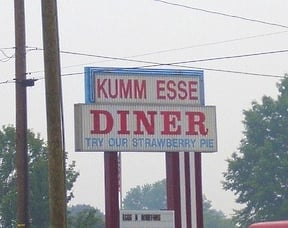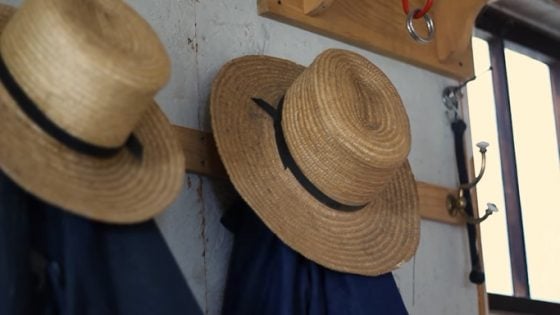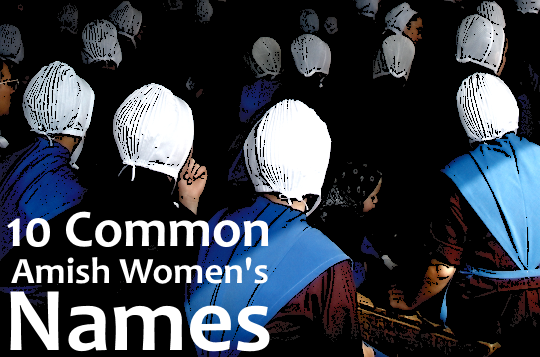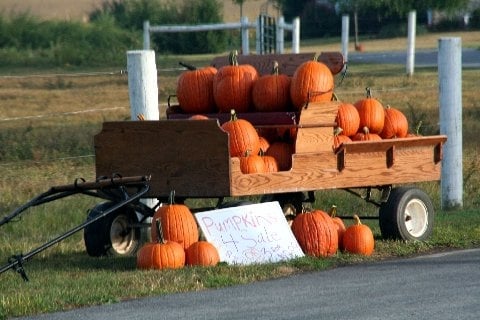5 Interesting Facts About Pennsylvania Dutch
“Sis en Bu.”
“Sis en Maedel.”
You’d hear these words often enough in Amish homes, with their ever-expanding families.
These Pennsylvania Dutch phrases mean “It’s a boy” and “It’s a girl,” as noted in a recent article on the language, “Keeping the Pennsylvania Dutch language alive – and thriving.”

Is Pennsylvania Dutch alive and thriving? Well, it depends where you look.
Patrick Donmoyer and Douglas Madenford are two trying to keep the tongue going into the 21st century and beyond.
Donmoyer is director of Kutztown University’s Pennsylvania German Cultural Heritage Center, while Madenford might be described as an evangelist for the language.
Madenford grew up hearing Pennsylvania Dutch on a family farm. He says he speaks only PA Dutch to his preschool-aged children.
Madenford also has a series of Youtube videos teaching the Pennsylvania Dutch language.
In the article, the two share the background of the language, and the story today.
5 Interesting Facts on the PA Dutch Language
Here are 5 interesting things from the article:
- 400,000 people speak Pennsylvania Dutch – Given that the current Amish population is over 300,000, the great majority of these speakers are Amish
- It’s getting rarer outside the Plain community – Some non-Plain speakers of PA Dutch remain. But the average age of “nonsectarian” speakers is 75, while for the Amish it is just 17
- Yet it’s the fastest-growing small-minority language in the US – Thanks to the sky-high Plain birthrate, PA Dutch is actually thriving
- PA Dutch speakers can communicate well in Germany – Despite the misleading name, PA Dutch is in fact a form of German. The article puts it this way: “In Germany, Pennsylvania Dutch speakers could get by in most of the country the same way someone from Vermont could function in Dublin or the Louisiana bayou.”
- Two World Wars hurt the language – After fighting two wars against Germany, the language fell out of favor. “It wasn’t in fashion to be speaking German in those times,” Madenford explains. “There was a real push and feeling that we really need to be more and more American in that post-World War II era, and the parents of baby boomers decided it wasn’t something we were going to teach our kids.”
What does it sound like?
If you’ve never heard Pennsylvania Dutch, here are a few samples for you. First, an Amishman conversing with a High German speaker:
Here’s a woman counting to 10 in Pennsylvania Dutch:
And if you understand German, here is a documentary on the language:
I’ve only managed to learn a few words and phrases in the language. Basically, so I can communicate with Amish friend’s children aged 6 and under.
Amish children typically begin learning English when they start first grade, though some of them pick it up sooner if they’re around it enough.







PA GERMAN'S DEMISE?
This reminds me of what was said of another language derived from old Rhineland German: Mamaloshen, known to everyone else as Yiddish. The Jewish people I know used to say of Yiddish: It’s been dying out for the past two hundred years! May there always be a “Pintele” (a little spark) of Yiddishkeit so that it may be fanned into a glowing, warm flame. May PA German have a “Fünkele”(little spark, Schwäbisch Dialect) of its own, so that the hearth may always be warm and “anheimelnd”(homey). Some say language is only a tool, and I feel sorry for those of that opinion. I know language to be the true repository of culture.
One more thing
One extremely sad language article I once read was of the death of a wonderful native Alaskan lady: Marie Smith-Jones. She of this most American of names passed away in the midst of a project with huge linguistic value. You see, she was the last person of her tribe who had a complete knowledge of their original native language and tribal rituals. The project was: a comprehensive lexicon and grammar of their Eyak language.They only managed about half of what they set out to do, and her passing in 2008 left a void that is indeed tragic. A quote from a favorite author, the late Elias Canetti, who spoke Ladino (a Jewish-Spanish language with vocabulary from before the time of Cervantes, also a minority language in danger of dying out): The loss of a single language is as if an entire universe perished.
languages
In my personal opinion I feel that if you are a citizen of a country you should speak their language, which I might add the Amish do when among non Amish. I have a problem with people who become citizens and expect us to learn their language, refusing to learn the language of our country. I know several who immigrated to US and refuse to learn our language.
Learn the language
True! Although I speak German every chance I get, write my shopping list in ourbeautiful old Sütterlin script, read it for pleasure and sing the old songs, I am proud to be bilingual. As a dear friend from Thüringen said when the subject of immigration to America immediately said, (and we were in our Teutonia Männerchor German Singing and Cultural Society at the time) “They need to learn English!” It is well known that, to their(our!)credit Germans have always been among the first and fastest groups to assimilate.
I think retaining your own community language is perfectly fine. PA German is one of the oldest spoken languages in the U.S. In fact, it has been spoken in the U.S since before the U.S was even a country.
You can only respect and appreciate these languages, especially the minority languages such as PA German and Louisiana French (aka Cajun). They are a unique part of American history. They link the open, wild, and young colonial America to today. It s a bridge of culture, time, and people.
Language
I was born to German-Russian parents in North Dakota in 1945. I spoke the Pennsylvania Dutch language until I went to a small country school for 1st grade. My parents spoke this language at home until the sixties. Even in the seventies if we went to small town restaurants you would still hear some of the senior citizens speak this. We called it German from Russian. We visited in Shipshewanna last spring and I got to practice it with a wonderful Amish man. He seemed a little stunned when I began to ask him questions. Love the Amish books. Not so much the romance, but the history.
Hello Carol,
Being that you are Russian-German, are you sure you’re speaking of PA Dutch and not Plautdietsch?
Both languages belong to groups that have a shared history, but are different. Plautdietsch is a moribund language in the U.S, but it is still spoken by traditional Mennonites in Latin America. There are videos online of the language.
it is not DUTCH --> it is DEUTSCH
both languages are similar,
nevertheless here it is clearly a dialect of the German (DEUTSCH)
(e)s is e(n) Buub
(e)s is e(n) Mädel
I want to got there so much
and do some culture studies…
Oliver, as for Dutch/Deutsch, this is the relevant bit from the article:
The Pennsylvania Dutch language — this can get confusing — is German, not Netherlands Dutch. It was spoken in the Rhine Valley and southwestern Palatinate region of what today is Germany.
“The average Pennsylvania Dutchman, if you dropped them in the Netherlands, would be lost,” Madenford said.
In Germany, Pennsylvania Dutch speakers could get by in most of the country the same way someone from Vermont could function in Dublin or the Louisiana bayou.
In America, there was an academic movement to drop the word Dutch and call the language Pennsylvania German, but one of the distinct traits of the region — stubbornness — won out.
“There was no country called Germany, and there was no national identity called German at the time these people were coming here,” Donmoyer said. “Culturally, there was an identity but it was very regional, not a national idea like there is today. One would be a Palatine, or a Swabian, or an Alsatian, or Swiss, etc.”
There’s a popular opinion that the word “Dutch” is a corruption of “Deutsch,” the word for the German language. When settlers were coming to Pennsylvania in the 18th century, Donmoyer said, the word “Dutch” was Old English for speakers of High and Low German, not a specific country.
Hi Erik,
I have to disagree with Donmoyer about there being no common understanding of a German nation until the modern age. The term “nation” itself does not traditionally mean a legal entity with borders or even a singular culture or linguistic speaking population. In ancient times the German nation would have meant the Germanic tribes. In the mid evil and later times “nation” for Germans meant a common ethnic-linguistic heritage. That is why the old Holy Roman Empire, despite being a merger of separate linguistic enclaves, was officially called the Holy Roman Empire of The German Nation. That is why German communities throughout Europe were still considered part of the German nation whether they spoke High Deutsch or not, or lived within Germany’s modern geographic limitations or not. Catherine the Great didn’t care that the Germans she invited to Russia were low German speakers or high German speakers…., just that they were German.
I was mainly replying in response to what seemed like confusion over the term “Dutch” (as in what is spoken in the Netherlands)…I can’t comment on the history you described, but I found your comment interesting.
Speak the native language
So euroAmericans think everybody should learn English? Have they learned the local (ie Indian) language? English speakers should remembered that they are immigrants or descendants of immigrants!!
speak English
I know,have worked with many ‘NATIVE Americans. Very few are full-bloods, & have never met one that does not speak American English. Most speak naught else. One learns the language needed to function & survive. Did the English & Norman invaders learn Erse or any Gaelic or Keltic languages?
Learning the Language
If you read my comments, you will notice I never suggestey the extreme view that people should be forced to speak only the English language or give up their culture. To get by in any country, however, and to enjoy the good things of the culture, that is, to live in it, not just briefly visit, knowing a way “in” is necessary. What is that way? Language. Please note in my comments: I am practically the East Coast Distributor of learn, maintain and enjoy languages plural!! I am living proof that you don’t have to gove up a language to gain another. I have just about all of the Amish German language prayerbooks, hymnals and the huge Märtyer Spiegel, and besides German and English I read and speak French and have a reading knowledge of Hebrew and Yiddish. I am also musical, a pianist, organist and trained singer, so add the language of music to it, and there I am. I am not suggesting giving up a blessed thing. Knowledge is precious, and I gained a lot through all of my languages. About culture: I have recipes and customs that hardly anyone makes or maintains any longer, and which many Americans might feel are foreign. Nobody ever told me I am not allowed to maintain them. By the way, my Linzertorte, Pfeffernüsse and Sandtörtchen get rave reviews at Christmas, and my Tsimmes I make for Thanksgiving they say is delicious as well
There you go ...
I agree with what you wrote Jim. My mothers family spoke Alsatian at home, in their business dealings and around their community … up until WWI. After that the usage of it, particularly in public was sharply curtailed. It was strictly forbidden in the public and parochial schools in their area.
My mother learned it after a fashion, but was never fluent in it. More like she could understand most of it, but was not comfortable speaking it. I wished that she had been truly bilingual, as I would have liked to learn it. That just wasn’t possible. I always thought that was a shame.
In the same way I thought it was shame when some of the Hispanic children that I grew up with told me that their parents discouraged them from learning Spanish. Something just doesn’t seem right with that. I think it would be hard to understand your own cultural identity if you couldn’t speak the language.
Now among the Hispanics that live in our area there is a strong resistance to learning English. What a change of mindset. There are women in our town that my wife has known for roughly 30 years that still speak no English. It makes me believe that they really don’t want to fully participate in the American experience. I get the impression that they view themselves as “temporary” Americans and not really interested in being fully involved in our community. Not sure how this could be viewed any differently.
BTW: Did you realize that there is no longer a region called Alsace in France? It is now just part of a larger area called Grande Est. From what I understand the use of the Alsatian language to conduct business or in education is forbidden.
Alsatian
you should make it more clear that the Alsatian you mention is one dialect of the German language,
spoken in the Region of Elsaß
but is now a part of France (re-named as “Alsace”).
Straßburg (which is the seat of the EUROPEAN parliament now)
was one of the most important German (ethnic and culture) towns of medieval Germany.
Nowadays, though there are many German villages, but the strong national policy of France also provided for a higher percentage of the use of the French language in the region now.
So: some “Alsatians” nowadays speak fluent English, others fluent French!
Some Alsatian-German dialect is left there in the Elsaß region of France, spoken at home, or at some occasions.
Thanks Oliver
Thanks for the additional information Oliver. It was my understanding that there is officially no longer a region called Alsace, nor the alternative German spelling. That could be incorrect, or a misunderstanding on my part though. I have been known to be wrong in the past!
I guess languages die out for a variety of reasons. Lack of usage is an obvious reason. The town we live in was settled predominately by people of German descent, though they spoke what is now considered to be the “Standard” German dialect rather than one of the “High” German dialects such as my mothers family and my fathers maternal side spoke.
When we moved there in 1985, one of the first things I noticed was that any time there was a gathering of any sort where several
“elderly” people were present they would invariably speak German for at least part of their conversation.Now we moved there in our early 30’s; so what I thought was “elderly” at that time might not be what I think of as being “elderly” today!
Regardless, around 10 to 12 years ago I suddenly realized that it had been quite some time since I had heard German spoken in public in our community. It took me a little while to realize that many of those people that I thought of as “elderly” in 1985 were by now truly elderly, many of them possibly deceased. I guess the bottom line is that the generation that was bilingual in German and English in our community is either now so elderly that they are no longer getting out much, or, they have passed away.
Regardless, for all intents and purposes German is no longer spoken publicly in our town.
BTW: NOT being a linguist of any sort, I am curious about that little symbol at the end of the Germanized spelling of “Alsace”. What is that symbol called? What does it mean? How in the world do I find that symbol on a keyboard?
Elsass
Elsaß
you may believe it or not, just 10 minutes ago I had a big problem with this German letter, it is “sz”, and that sign is in old German script. it is a part of many names and even words.
saß = (he) sat
ich heiße = my name is (this is Latin [name])
ist = is (we can also say “mein NAME ist…” [Latin version]
Scheiße = shit
muß = now changed ortho: “muss” = must
Haß = now changed ortho: “Hass” = hate
daß = now changed ortho: “dass” = (so) that
only the …ß for longer sound of a syllable is maintained in the writing now.
Elsaß in fact will be Elsass now (reform some 15 years ago).
the Alsaciaen explained me, this landscape and region name is from the river El or similar, and the -saß (means sit; come down).
It is neighboring to the Rhein (Rhine) River.:
I love it to be there in the Elsass, like in every German settlement region, for the study of their culture and language (dialects).
Last time I was there in end of July 2017.
I was welcome by people I did not even know, and they showed me some historical places, and we talked, in their German dialect.